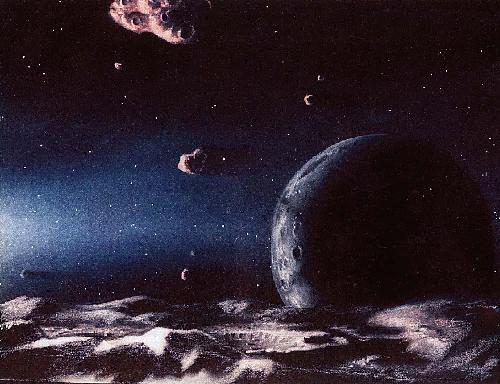|
The Edge of the Kuiper Belt
|
Introduction
The Classical Kuiper Belt has an edge at about 47 AU. It may
have been carved by tidal truncation or represent the outer
limits to which objects were pushed by Neptune's
migration.
Detection of the Edge
"The observed radial distribution of KBOs is deficient
in objects beyond about 50 AU, relative to simulations of
power-law Kuiper Belt disks. We have no firm explanation
of this observation. The Kuiper Belt might be truncated at
about this distance, there might be a steep decrease in the
maximum size of KBOs at larger heliocentric distances, or
some combination of these two effects might conspire to
yield the observed radial distribution."
Jewitt
et al. 1998
Later, the edge was confirmed in a smaller but deeper survey by
Allen et al. (2001)
and in a larger and deeper survey by
Trujillo et al. (2001).
The Cause of the Edge
The edge, like many other features of the Kuiper Belt, was not
expected or predicted by any prevailing theories. Perhaps for
this reason, its reality was accepted only slowly by many, but
it now is generally acknowledged as real. [Doubters asserted that the
edge is an illusion, caused by the faintness of more distant objects.
This possibility was rejected in the 1998 paper based on numerical
simulations of the data which show that we could see more distant
objects if they were present.]
The first group to attempt an explanation invoked tidal truncation
of the Kuiper Belt by a passing star (Ida et al (2000): Ap. J. 528,
351-356). To cut the disk at 50 AU, the star would have to pass
about 150 AU from the sun. Such a close encounter is highly improbable
in the present environment of the sun (the mean distance between stars
is near 1 parsec, or 200,000 AU). But if the sun formed in a dense
cluster, then perhaps such an encounter could have occurred.
Another explanation could be that the edge of the Classical Belt
simply marks the distance out to which objects were transported
after being swept along by the migrating Neptune 3:2 resonance,
which now coincides with the outer edge.
Still another, as noted above, is that the edge reflects a deficiency
only in the largest, most easily observed objects, but that smaller,
fainter objects exist beyond it. This possibility has grown weaker
since 1998, as new surveys of greater depth and area have failed
to find any more distant Classical KBOs.
Beyond the Edge
What is beyond the edge? We know that the
scattered KBOs
travel far beyond the edge - to 1000's of AU, in fact. But could there
also be a distant population of bodies on near-circular orbits, like a
continuation of the Classical Belt but at larger distances?
Observationally, the answer is a clear "yes", provided the outer belt
does not begin until 100 AU or more from the sun. Because the
brightness of objects viewed in reflected sunlight varies as a steep
(inverse 4th) power of distance, this possibility will be difficult to
refute. A better constraint is expected from the
occultation technique
, in which KBOs can potentially be detected from their
shadows.
David Jewitt
 Kuiper Belt
Kuiper Belt